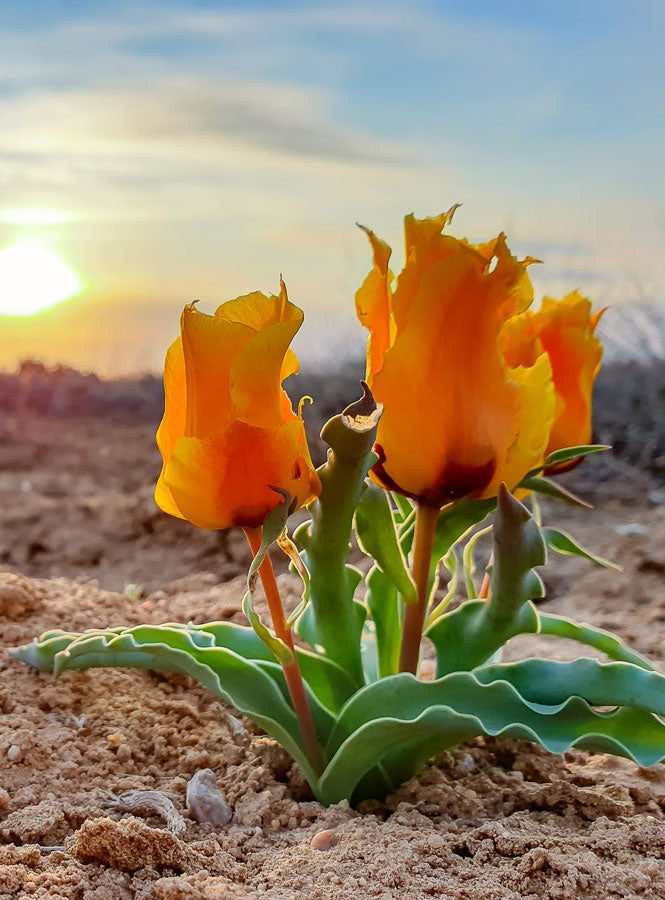Dutch Tulip Hunters Travel Rough, Armed with Cameras
Tulips are among the most recognizable flowers in the world. Yet it may surprise many to see them growing wild in their native habitats. Genteel tulips originated in some of the most rugged places on earth, tough survivors that cling to desert mountain ridges and thrive on barren windswept steppes.

The website tulipsinthewild.com presents these rare wild tulip species photographed in their harsh habitats. The site, created by the Amsterdam Tulip Museum and the U.S. flowerbulb wholesaler Colorblends is a tribute to five Dutch tulip enthusiasts who traveled to remote regions of the world on a 20-year quest to find and photograph tulip species in the wild. These modern-day botanical explorers braved threats from extreme weather and terrain, armed gangsters, wild animals and more. A collection of their images is visible at the Amsterdam Tulip Museum and online.
Tulips in the Wild
The expeditions began in the mid-1990s when Dutch bulb expert Eric Breed and his friend, tulip and lily hybridizer Arie Peterse, treated their wives to a spring vacation in Crete, the mountainous Mediterranean island famous for its beach resorts. What they didn’t play up was that Crete is also the only place in the world where a certain rare tulip species might be found.
On Crete the two men left their wives to enjoy the beach and set off to explore the island by Jeep and on foot. Along narrow dirt tracks, up rugged mountainsides, they quizzed shepherds and farmers and their wives. Finally, outside a tavern near the mountain village of Spili, a group of men surprised them with their responses. “Some years this flower blooms, some years it doesn’t,” they said. “This year it blooms. You want to see it? Fine. But first we drink raki.”
A short time later, six shots of the high-octane home brew fueled non-drinkers Eric and Arie in pursuit of their quarry. The instructions were simple: cross the stone bridge, follow the creek upstream to a waterfall, search for a fence with a painted sign of a black turkey in front of a steep slope. Start climbing. They did, and there it was: Tulipa cretica, with its soft pink-white flowers blooming in clusters.
The two men were hooked and quickly planned new explorations to find and photograph rare tulips in the wild. Soon fellow tulip adventurers, Sjaak de Groot, Willem Lemmers, and Marijn van den Brink joined the group. Over the next two decades, the participants on any given trip varied as they launched expeditions to the mountainous regions of Central Asia, the Mideast and China.
Led by local guides, the hunters explored remote ranges of the Himalayan, Caucasus, Tien Shan, Elburz and Pamir mountains of Kazakhstan, Kyrgyzstan, Uzbekistan, Tajikistan, Iran, and Afghanistan. In the former Soviet republics, Vladimir Kolbintsjev joined as trusted friend and guide. Their carefully planned treks relied on sturdy mountain pack horses to traverse exposed steppes, slick glaciers, and narrow mountain paths with precipitous drops. They skirted big cats, bears, wild boars and nervous military patrols.
In a border incident near Chechyna, it was gangsters meet galanthus when Eric and Ari were present at a tense face-off between a World Wildlife Federation representative and a local mafia-type chief. While the WWF rep negotiated to end trafficking in wild-collected galanthus, also called snowdrops, multilingual Eric and Arie, seeking to ease the mood, warily chatted with the gun-toting thugs who blocked the exit door.
A Treasure Trove of Precious Photographs
The contrast of harsh habitat and colorful tulips resulted in a collection of dramatic photographs now viewable for the first time online. The tulipsinthewild.com site features an interactive map that illustrates where different tulip images were captured. The site offers more than forty images, each with Eric’s brief description of the flower and the location where it was found.

